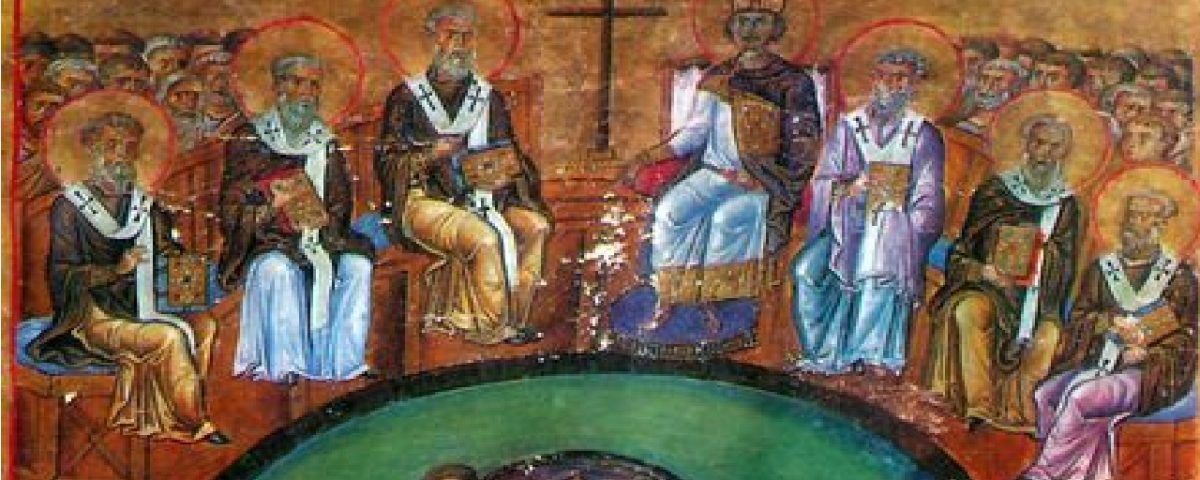
The Virgin Birth in John 1:13
December 13, 2019
Concerning Christmas Carols
December 13, 2019The Loss of the Messianic Jesus in the Early Struggles over Christology

by Anthony Buzzard
From the early second century, or even earlier in the days of John, and calling forth John’s impassioned plea to stay with Jesus Christ the “human, historical begotten Son” who came en sarki (1 John 4:1-6; 2 John 7; 1 John 5:18, not KJV), “in the flesh,” not “into the flesh” — as though John were a good proponent of the Incarnation of the eternal Son —the battle raged over the relationship of the Son to the Father. It was the famous Logos teaching of John 1:1 which provided a storm center for the various views. The great question was, how are we to understand the Logos which/who was with God and “was God”?
In his History of Dogma, Adolf Harnack discusses early opposition to the emerging idea that John’s Logos must denote the preexistence of a pre-Genesis, created Son of God and later “eternally begotten” Son of God — a member of the eternal Trinity. This opposition to developing Trinitarianism, Harnack says, “was called forth by interest in the evangelical, the Synoptic idea of Christ [the Christ described by Matthew, Mark and Luke]. With this was combined an attack on the use of Platonic philosophy in Christian doctrine” [Had not Paul alerted us to the subtle danger of philosophy?] “The first public and literary opponents of Christian Logos speculations did not escape criticism that they depreciated the dignity of the Savior.” In other words those who did not think that speculating about a preexisting, prehistoric Son was valid were accused, as today, of saying that Jesus was “just a man” and somehow therefore inadequate to the task of being the Savior. What do we know of these early unitarians?
You will recognize here many of the themes of our own conference this year, nearly 2000 years later.
Harnack: “With the Monarchians [the unitarians] the first subject of interest was the man Jesus.” They were doing their Christology in other words “from below,” or “from behind,” beginning with the prophecies of the Hebrew Bible, and not “from above,” as though the Savior arrived from a pre-mundane existence in heaven — what later became the full-blown doctrine of the Incarnation.
Harnack really captures my attention when he muses as follows: “Did not the [developing] doctrine of the heavenly aeon who became incarnate in the Redeemer contain another remnant of the old Gnostic leaven?” [Paul warned us also against the insidious effects of “gnosis” falsely so-called, 1 Tim. 6:20.] “Did not the sending forth of the Logos (probole of the Logos) to create the world recall the [Gnostic ideas] of the emanation of the aeons? Was not ditheism [belief in two Gods] set up if twodivine beings were to be worshiped? Not only were the uncultured Christian laity driven to such criticisms…but also all those theologians who refused to give any place to Platonic philosophy in Christian dogmatics?”[p. 9]
Harnack maintained that not all theologians were happy with projecting the human Son of God back into pre-history. The whole process smacked too much of the Gnostic idea that the one unapproachable God must be mediated to us via a lesser intermediary, an Aeon.
And what was at stake in the struggle over the identity of Christ as Son of God in relation to the One God of Israel? What eventually happened when one of the competing parties established itself as the only “orthodox” faith? Harnack again: “For the great mass of the laity in the East the mystery of the person of Christ took the place of the Christ who was to have set up his visible Kingdom of glory upon earth.” [p 9]
So then, along with the struggle over who Jesus was went the companion struggle over the Gospel of the Kingdom. Christology and eschatology went hand in hand as subjects of the ongoing battle between what Bart Ehrman calls “proto-orthodoxy” and its rival — which was really an original view of Jesus which was finally denounced as heresy.
Bart Ehrman as a sort of contemporary Harnack on a smaller scale maintains that original Truth was eventually banished as heresy. The new “orthodox” then consolidated their victory over original truth by destroying the literature of their defeated opponents and centering authority in a single bishop over each church (later headquartering him with supreme power in Rome). Thus Ehrman in his fascinating recent book Lost Christianities: The Battle for Scripture and the Faiths We Never Knew writes of the second century:
“In some regions of ancient Christendom, what later came to be labeled ‘heresy’ was in fact the earliest and principal form of Christianity. In other regions views later deemed heretical coexisted with the view that came to be embraced by the church as a whole…To this extent ‘orthodoxy,’ in the sense of a unified group advocating an apostolic doctrine accepted by the majority of Christians everywhere, simply did not exist in the second and third centuries.”
Harnack describes what appears to be an alarming loss of the actual Jesus of history. At the heart of the disputes which fractured Christian unity was the matter of the origin of Jesus as Son of God. Was that origin in history or in prehistoric times?
“The struggle was a strenuous effort of Stoic Platonism to obtain supremacy in the theology of the Church; the victory of Plato over Zeno and Aristotle in Christian science. The history of the displacement of the historical Christ by the preexistent Christ, of the Christ of reality by the fictitious Christ, in dogmatics; finally, as the victorious attempt to substitute the mystery of the person of Christ for the person himself, and by means of a theological formula unintelligible to the laity, to put the laity with their Christian faith under guardians…When the Logos Christology obtained a complete victory, the traditional view of the Supreme deity as one Person [i.e. an original unitarianism] and, along with this, every thought of the real and complete humanity of the Redeemer was in fact condemned as being intolerable in the Church. Its place was taken by the [impersonal, human] nature of Christ which without the person is simply a cipher. The defeated party had right on its side.”
Harnack goes on to describe the history of that defeated party which “would not give up the personal, numerical unity of God” — i.e., second- and third-century unitarians like Paul of Samosata, Bishop of Antioch deposed for “heresy” in 268 AD, the Theodotians and Artemon. These were all labeled as heretics, beyond the pale of the true faith. And so it has remained until today. And thus the struggle seems to persist unresolved.
Professor William Sanday, once Professor of Divinity at Oxford, in his article on the Son of God in the Hastings Dictionary of the Bible tells us that there is no support at all in the Synoptic Gospels for a preexisting Son of God. Are there verses in John which would lead us to think that the Son predated his birth? Sanday says: “Perhaps there are not any.” Unintentionally he supported our “Socinian”[7] view of Jesus as the uniquely begotten Son (Luke 1:35; Matt. 1:18, 20). James Dunn is surely more widely read than anyone on our subject. In his classic Christology in the Making he makes Luke the proponent of a view which we find convincing:
“In his birth narrative Luke is more specific than Matthew in his assertion of Jesus’ divine Sonship from birth (1:32, 35, cp. 2:49, “my Father’s house”). Here again it is sufficiently clear that a virginal conception by divine power without the participation of any man is in view (1:34). But here too it is sufficiently clear that it is a begetting, a becoming which is in view, the coming into existence of one who will be called, and will in fact be the Son of God, not the transition of a preexistent being to become the soul of a human baby or the metamorphosis of a divine being into a human fetus. Luke does state a little more fully and with powerful imagery, the means by which this divine begetting would take place — by the holy spirit coming on Mary, and the power of the most High overshadowing her (1:35). The latter verb (episkiasei) may well contain an allusion to the divine presence which overshadowed the tabernacle in the wilderness (Ex. 40:35), but the thought is not that of a divine presence (or being) becoming or being embodied in Jesus; in this phrase Luke’s intention is clearly to describe the creative process of begetting…Similarly in Acts there is no sign of any Christology of preexistence.”
Dunn quotes John Knox and agrees with him.
“For the author of Hebrews Jesus is the Son not in virtue of some precosmic divine existence, but as the pioneer of man’s salvation…The author of Hebrews has no place in his thinking for preexistence as an ontological concept. His essentially human Jesus attains to perfection, to preeminence and even to eternity.”
The whole idea of preexistence is challenging, though few seem to be aware of any contradiction between the coming into existence of the Son by begetting and the preexistence of the Son in eternity. James Mackey has given much attention to Christology. His chapter on “The Problem of the Preexistence of the Son” begins like this:
“It is best with this particular problem, not only because there are linguistic difficulties here — as soon as we recoil from the suggestion that something can preexist itself — we must wonder what exactly, according to this term, preexists what else, and in what sense it does so — but because it leads directly into the main difficulties encountered in all Incarnational and Trinitarian theologies. In addition, though biblical scholars are often not slow to suggest that the constructions of the systematic theologian show themselves to have exegetical feet of clay, it does not take a systematician of any extraordinary degree of skill to notice how exegetes themselves are the unconscious victims in the course of their most professional work of quite dogmatic, that is uncritical systematic assumptions.”
Yes, indeed. What is this curious notion of “preexistence” all about? How is it that no New Testament writer used the perfectly good verb prouparchein (to preexist) of the Son of God? How is that Justin Martyr, a hundred years after Jesus, uses it often? How is that the NT speaks of Jesus “coming into existence” in and from the womb of his mother while Justin thinks of the Son engineering his own Incarnation and coming through the womb of his mother? How in fact can the Son be both six months younger than his cousin John and yet billions of years older? Was he really only 30 years old at the inception of his ministry or much, much older? It is the same James Mackey who notes most insightfully that “spirit is one of the most ancient symbols in Near Eastern cultures for God and particularly for God’s active presence in our world. Son is one of the most powerful natural symbols known by which to express the extension of one’s favor to a person who is the very continuation of one’s effective presence in the world…[It is to say that] God acts in Christ.” By the spirit, by creative miracle, God produced the Son, the second Adam, and as Son he expresses the Plan, the immortality, Kingdom Plan which invites us to indestructible life, to be gained not by survival of a disembodied soul, but by resurrection/rapture when the Messiah returns to rule on the throne of David.
Imagine our delight at finding the Ex Auditu article of Dr. Brown. Critical of what he calls the “social Trinity,” he speaks of “a systematic misunderstanding of Son-of-God language in Scripture.” Here he puts his finger, surely, on the age-old conflict. Dr. Brown says:
“Indeed one may ask whether the term ‘Son of God’ is in and of itself a divine title at all. Certainly there are many instances in biblical language where it is definitely not a designation of deity.”
He goes on to illustrate his point from the Bible. Then he says:
“In the light of these passages in their context, the title ‘Son of God’ is not in itself a designation of personal deity or an expression of metaphysical distinctions within the Godhead. Indeed to be ‘Son of God’ one has to be a being who is not God! It is a designation for a creature indicating a special relationship with God. In particular, it denotes God’s representative, God’s vice-regent. It is a designation of kingship, identifying the king as God’s son.”
A marvelous statement! Should not this be made compulsory reading for every student in every land entering the halls of theological seminaries? Our joy of course was made even fuller when we read in the same article that it is a systematic mistake to read “I and the Father are one” (John 10:30) and statements about the mutual indwelling of Jesus and the Father (John 10:38; 14:10, 11, 20; 17:21, 23) as statements about “inner relations of the ‘persons’ of the Trinity.”
“The Fourth Gospel itself does not require such a reading. When read in context the statements are evidently statements about Jesus’ relationship with the Father on earth.”
Dr. Brown continues:
“It is a common but patent misreading of the opening of John’s Gospel to read it as if it said: ‘In the beginning was the Son and the Son was with God and the Son was God’ (John 1:1). What has happened here is the substitution of the Son for Word (Greek logos), and thereby the Son is made a member of the Godhead which existed from the beginning. But if we follow carefully the thought of John’s prologue, it is the Word that preexisted eternally with God and is God.”
http://www.theologicalconference.org/media/docs/pdf/2004/Buzzard.pdf

